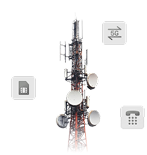Fueling Government Innovation with MuleSoft-Powered Digital Integration
Application Integration
Overview
A large public sector entity recognized the need to address functional silos, data duplication, and interoperability challenges to improve operational efficiency and strategic decision-making. The initiative focused on integrating critical systems within its Strategy & Future Department, creating streamlined workflows, enabling consistent governance, and fostering a collaborative operating environment for greater effectiveness.
The Challenge
The organization faced significant hurdles impeding its ability to operate seamlessly across departments:

- Fragmented Systems: Existing systems operated in silos, with minimal or no integration, resulting in inefficiencies and redundant efforts.
- Data Accessibility Issues: Real-time financial and performance data were difficult to access across systems, delaying decision-making processes.
- Lack of Unified Monitoring: Decision-makers struggled to track progress, risks, and operational performance due to the absence of an integrated platform.
- Manual Reporting Processes: Reporting lacked automation, making it labor-intensive to derive actionable insights.
The Objective
The organization aimed to establish a robust integration framework that would:

- Connect Core Applications: Integrate critical systems like the Operating Plan (OP), Enterprise Risk Management (ERM), Institutional Performance Management System (IPMS), and Policies & Procedures Management System (PPMS).
- Facilitate Financial System Interoperability: Enable seamless data retrieval from the financial system.
- Deliver Unified Navigation: Provide a single, intuitive interface to access and operate all integrated systems.
- Enhance Decision-Making: Implement advanced reporting and dashboards for real-time monitoring of progress, risks, and performance metrics.
- Ensure Scalability: Establish a future-ready foundation for integrating additional government systems.
The Solution
Tellestia implemented MuleSoft, a leading integration platform, to address these challenges with a scalable, agile, and reusable integration framework. Key solution components included:

- API-Led Connectivity
The backbone of the solution was MuleSoft’s API-led architecture, comprising three distinct API layers:- System APIs: Directly interfaced with back-end systems (e.g., OP, ERM, IPMS, and PPMS), enabling seamless data extraction.
- Process APIs: Aggregated and processed data from multiple system APIs to meet functional requirements, such as combining ERP financial data with strategic project updates.
- Experience APIs: Simplified user access by providing a unified interface for dashboards, reporting, and system navigation.
- Decoupling Systems for Independence
Tellestia used MuleSoft middleware platform to decouple tightly connected systems, allowing them to operate independently.- This reduced the risk of cascading system failures and improved system performance.
- MuleSoft handled all data transformations, enhancing network bandwidth utilization and ensuring smooth communication between systems.
- Reusable APIs for Efficiency
To drive cost efficiency and agility, the solution emphasized reusable APIs:- APIs designed for financial data integration were reused for risk analysis and reporting, minimizing duplication.
- Flexible API structures enabled quick adaptation to new reporting or system requirements.
- Hybrid Deployment Model
Tellestia implemented a hybrid deployment combining cloud-based and on-premise systems:- Cloud Deployment: Used for scalable systems like IPMS, enabling accessibility across teams.
- On-Premise Deployment: Applied to sensitive systems like the financial ERP to ensure security and compliance.
- Unified Dashboards and Reporting
The integration layer facilitated real-time data visualization and reporting through:- Unified Dashboards: Consolidating data from all systems into a single, interactive view for decision-makers.
- Advanced Reporting: Automating report generation for diverse stakeholder needs, from executive summaries to detailed project metrics.
- Accelerated Time-to-Value
- Leveraging MuleSoft’s plug-and-play capabilities, reusable APIs, and simplified tools, Tellestia ensured a rapid implementation timeline.
- The organization quickly began addressing inefficiencies and improved its interoperability without prolonged disruption.
- Scalability for Future Growth
The solution was designed to scale seamlessly for future integrations, supporting:- Collaborations with additional government entities, including alignment with the Prime Minister’s Office.
- Integration of new systems, whether cloud-based or on-premise, into the existing framework
The Impact
The transformation delivered measurable improvements in operational and strategic outcomes:

- Enhanced Interoperability: A centralized integration layer enabled seamless communication across previously siloed systems.
- Improved Operational Efficiency: Data duplication and redundancies were reduced, streamlining workflows and boosting productivity.
- Empowered Decision-Making: Real-time dashboards and automated reporting provided leaders with actionable insights into key metrics and risks.
- Future-Ready Framework: A scalable architecture was established to support ongoing integrations with additional government systems.
- Increased ROI: Reusable APIs reduced development costs and enabled faster time-to-market for subsequent integration efforts.

Let’s Get Started on Your Transformation Journey.
You Might Also Like

Automating Claims and Payments through Oracle Health EHR Integration with Insurance Providers
Learn how a leading Dubai healthcare provider automated claims, payments, and pre-authorizations by integrating Oracle Health EHR with UAE insurance...
Read Story
Oracle Health EHR Integration with Microsoft Dynamics 365 ERP
Facing delays in billing and inefficient inventory management, a healthcare provider needed to connect its Oracle Health EHR with its...
Read Story
Enabling Agile Real Estate Operations through Enterprise-Grade iPaaS Integration
A leading UAE-based real estate developer partnered with Tellestia to modernize its IT infrastructure through a scalable, secure, and efficient...
Read Story



















